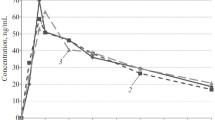Summary
Antecubital venous blood was sampled at rest and during orthostasis or supine bicycle exercise. The plasma was analyzed for noradrenaline and 3,4-dihydroxyphenylethyleneglycol (DOPEG) by HPLC.
Orthostasis resulted in increases in plasma concentrations of both noradrenaline and DOPEG. The magnitude of changes in both was dependent on the degree of orthostasis. In conditions of supine rest, sitting, and standing the plot of the geometric mean values of plasma DOPEG (ordinate) against those of plasma noradrenaline was linear, had a slope of about unity, and intersected the ordinate at a finite value of plasma DOPEG.
After administration of desipramine (to block uptake1), plasma concentrations of DOPEG fell both at rest and during orthostasis. Moreover, desipramine abolished the plasma DOPEG response to orthostasis without affecting the plasma noradrenaline response. Hence, changes in plasma DOPEG brought about by changes in sympathetic tone are presynaptic in origin.
The plasma concentration of DOPEG observed in the presence of desipramine was virtually identical with the ordinate intercept of the regression line relating plasma DOPEG to plasma noradrenaline in the absence of desipramine. This pool of plasma DOPEG (which amounted to about 75% of that observed at supine rest in the absence of desipramine) probably stems from intraneuronal noradrenaline leaking out of the storage vesicles of peripheral sympathetic neurones and may in part also be derived from the central nervous system.
Supine bicycle exercise failed to increase plasma DOPEG. This may be due to the separation of the sampling site from the site of noradrenaline release (i.e. the exercising limbs) by organs involved in DOPEG extraction. The failure of plasma DOPEG to rise under these conditions may also be a consequence of increased blood flow in the exercising limbs, resulting in a marked decrease in the proportion of the released noradrenaline being recaptured by the sympathetic nerve endings.
Similar content being viewed by others
References
Brown MJ (1984) Simultaneous assay of noradrenaline and its deaminated metabolite, dihydroxyphenylglycol, in plasma: A simplified approach to the exclusion of phaeochromocytoma in patients with borderline elevation of plasma noradrenaline concentration. Eur J Clin Invest 14: 67–72
Christensen NJ, Galbo H, Gjerris A, Henriksen JN, Hilsted J, Kjaer M, Ring-Larsen H (1984) Whole body and regional clearance of noradrenaline and adrenaline in man. Acta Physiol Scand 527: [Suppl] 17–20
Eisenhofer G, Goldstein DS, Stull R, Keiser HR, Sunderland T, Murphy DL, Kopin IJ (1986) Simultaneous liquid-chromatographic determination of 3,4-dihydroxyphenylglycol, catecholamines, and 3,4-dihydroxyphenylalanine in plasma, and their responses to inhibition of monoamine oxidase. Clin Chem 32: 2030–2033
Esler M, Jackman G, Bobik A, Kelleher D, Jennings G, Leonhard P, Skews H, Korner P (1979) Determination of norepinephrine apparent release rate and clearance in humans. Life Sci 25: 1461–1470
Esler M, Jackman G, Leonhard P, Skews H, Bobik A, Korner P (1981) Effect of norepinephrine uptake blockers on norepinephrine kinetics. Clin Pharmacol Ther 29: 12–20
Goldstein DS, Zimlichman R, Stull R, Keiser HR, Kopin IJ (1986) Estimation of intrasynaptic norepinephrine concentrations in humans. Hypertension 8: 471–475
Goldstein DS, Eisenhofer G, Stull R, Folio CJ, Keiser HR, Kopin IJ (1988) Plasma dihydroxyphenylglycol and the intraneuronal disposition of norepinephrine in humans. J Clin Invest 81: 213–220
Graefe K-H, Henseling M (1982) Neuronal and extraneuronal uptake and metabolism of catecholamines. Gen Pharmacol 14: 27–33
Grohmann M (1987) The activity of the neuronal and extraneuronal catecholamine-metabolizing enzyme of the perfused rat heart. Naunyn-Schmiedebergs Arch Pharmacol 336: 139–147
Halbrügge T, Gerhardt T, Ludwig J, Heidbreder E, Graefe K-H (1988) Simultaneous assay of catecholamines and dihydroxyphenylethyleneglycol in human plasma and its application in orthostasis and mental stress. Life Sci 43: 19–26
Henriksen JH, Christensen NJ, Ring-Larsen H (1986) Pulmonary extraction of circulating noradrenaline in man. Eur J Clin Invest 16: 423–427
Howes LG, Miller S, Reid JL (1985) Simultaneous assay of 3,4-dihydroxyphenylethyleneglycol and norepinephrine in human plasma by high-performance liquid chromatography with electrochemical detection. J Chromatogr 338: 401–403
Iversen LL (1967) The uptake and storage of noradrenaline in sympathetic nerves. Cambridge University Press, Cambridge
Izzo JL, Thompson DA, Horwitz D (1985) Plasma dihydroxyphenylglycol (DHPG) in the in vivo assessment of human neuronal norepinephrine metabolism. Life Sci 37: 1033–1038
Kaltenbach M (1974) Die Belastungsuntersuchung von Herzkranken. Mannheimer Morgen, Großdruckerei und Verlag, Mannheim, pp 39–52
Kopin IJ (1985) Catecholamine metabolism: Basic aspects and clinical significance. Pharmacol Rev 37: 333–364
Langer SZ (1974) Selective metabolic pathways for noradrenaline in the peripheral and in the central nervous system. Med Biol 52: 372–383
Langer SZ, Farah MB, Luchelli-Fortis MA, Adler-Graschinsky E, Filinger EJ (1975) Metabolism of endogenous noradrenaline. In: Tuomisto J, Paasonen MK (eds) Proceedings of the 6th International Congress of Pharmacology, vol 2. Finnish Pharmacological Society, Helsinki, pp 17–31
Ludwig J, Halbrügge T, Gerhardt T, Walter J, Graefe K-H (1987) Plasmakonzentrationen von Noradrenalin (NA) und des desaminierten Metaboliten Dihydroxyphenylglykol (DOPEG) bei verschiedenen Formen erhöhter sympathischer Aktivität. Z Kardiol 76 [Suppl 2]: p 92
Paiva MQ, Guimaraes S (1978) A comparative study of the uptake and metabolism of noradrenaline and adrenaline by the isolated saphenous vein of the dog. Naunyn-Schmiedebergs Arch Pharmacol 303: 221–228
Robinson DS, Johnson GA, Nies A, Corcella J, Cooper TB, Albright D, Howard D (1983) Plasma levels of catecholamines and dihydroxyphenylglycol during antidepressant drug treatment. J Clin Psychopharmacol 3: 282–287
Sachs L (1984) Angewandte Statistik, 6th edn. Springer, Berlin Heidelberg New York
Trendelenburg U, Bönisch H, Graefe K-H, Henseling M (1979) The rate constants for the efflux of metabolites of catecholamines and phenethylamines. Pharmacol Rev 31: 179–203
Author information
Authors and Affiliations
Rights and permissions
About this article
Cite this article
Ludwig, J., Gerhardt, T., Halbrügge, T. et al. Plasma concentrations of noradrenaline and 3,4-dihydroxyphenylethyleneglycol under conditions of enhanced sympathetic activity. Eur J Clin Pharmacol 35, 261–267 (1988). https://doi.org/10.1007/BF00558263
Received:
Accepted:
Issue Date:
DOI: https://doi.org/10.1007/BF00558263




